It’s that time of year again- countless people are setting their new year’s resolutions to start hitting the gym and shed the excess pounds they gained over Christmas. Our mountain chickens on the other hand have a whole other agenda- to gain as much weight as possible! So, don’t be disheartened if your new regime isn’t going to plan- our frogs are leading the way with their body positive transformations!
As our mountain chickens are only 2 years old, they’re right on the cusp of adulthood, and with their first full breeding season on Montserrat fast approaching we are hoping to see them start piling on the pounds month by month as they work themselves into peak breeding condition. Thanks to a generous diet of cockroaches, crickets and wild prey items within their enclosures, we’re happy to say that this has been the case! And over the last few months many of our frogs have been really filling out. Since their arrival on island, we’ve been tracking this progress via monthly health checks, the information from which we review and send back to our husbandry and veterinary experts.
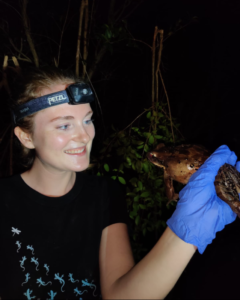 It’s not only weight gains and growth we’re assessing during these health checks, they are also a great opportunity for us to monitor for any signs of injury or disease within the population, in particular signs of the deadly chytrid fungus. We know that chytrid is widespread throughout Montserrat, but to treat it we need to be able to spot symptoms early, monitor the frogs progress fighting the disease and step in to provide treatment and support if necessary, just like any good doctor and their patient. Ensuring the frogs are fit and healthy is a huge part of the project, so I thought I (Rachel) would give you all an insight into what the health checks are all about.
It’s not only weight gains and growth we’re assessing during these health checks, they are also a great opportunity for us to monitor for any signs of injury or disease within the population, in particular signs of the deadly chytrid fungus. We know that chytrid is widespread throughout Montserrat, but to treat it we need to be able to spot symptoms early, monitor the frogs progress fighting the disease and step in to provide treatment and support if necessary, just like any good doctor and their patient. Ensuring the frogs are fit and healthy is a huge part of the project, so I thought I (Rachel) would give you all an insight into what the health checks are all about.
Back in December, I took part in my first mountain chicken health check and I’ve got to say, it is one of my favourite parts of the project so far! For many years as a child I wanted to be a vet. As time went on I realised that I wanted to work in conservation instead, however I will admit that a big part of me was still very excited to don a pair of gloves and start swabbing frogs and examining them for signs of disease! That is one of the great things about this field- you can turn your hand to many different trades. Alongside being a biologist, you are an electrician one day and a vet the next.
The day of the health check, we arrived at the fieldsite for sundown (the time when the mountain chickens start to emerge from their hides). It’s good to keep the team working within the enclosures as small as possible, to minimise stress to the frogs, so it was a bare bones team of myself, Luke and Blacka. Blacka is one of the founding mountain chicken experts on the team, having worked for the project since the very beginning. If you’ve ever tried to catch a chicken (the bird) before, this compares to the level of skill needed to catch a mountain chicken frog, except the frogs are slimier and can jump metres in a single bound! Blacka however caught the frogs with the utmost speed and precision of someone who has spent a lifetime working with them. He said that the key is to aim ahead of where you think the frog will be, to pre-empt the jump. With this in mind, by the time we reached the final frog, I felt brave enough to give it a go myself. I leapt to catch it and lo and behold, the mountain chicken sprung away at the last second. This happened another three times before it disappeared into the undergrowth. However, within seconds, Blacka emerged from the bushes clutching the disgruntled-looking frog and I secretly made it my aim to catch them with such ease one day.
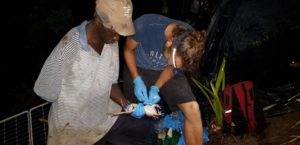
Once captured, each frog was gently washed to remove soil and then examined for signs of health & disease. The main things we are looking for are signs of health (good muscling, bright eyes, shiny skin) and any signs of injury or chytrid infection. In particular, the main signs of chytrid infection we are looking for include; reddening of the legs and underbelly, muscle tremors and a white milky line underneath the eye. These are all tell-tale signs of ill-health but can be tricky to spot when the frog is hopping around in the undergrowth. Then a couple of morphometric measurements were taken- the snout to vent length (SVL) and the length of each frog’s extended leg. Combined with the weight data, these measurements give us a good idea if the frog is growing at a healthy rate. To weigh the frogs, they are placed carefully into thick plastic bags and suspended from a scale.
One of the most important bits of data we collect during the health checks are the skin swabs, which we send back to our lab to be tested for chytrid. Each of these swabs is rolled along each frog’s belly, thigh, calf and foot carefully swabbing along the length of each long toe. It’s clear to see how they earned their Latin name, Leptodactylus fallax, as it literally translates into ‘slender fingers’. It is interesting to note as well that, unlike most frogs, there is no webbing on their toes and this reflects their lifestyle, as they rarely enter water and will spend most of their time on land.
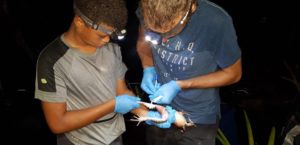
Before sending all the data to our team of international experts, it is compiled into a single document including a photo of each frogs’ face. These photos help us to monitor signs of injury or disease over time. The result of which is that my phone is now full of a vast array of mountain chicken mugshots and I can’t say I complain! Its great fun looking through them as each frog has a different expression, which I like to think reflects their personality. As you can see, some are smiley and some look downright angry at being captured.
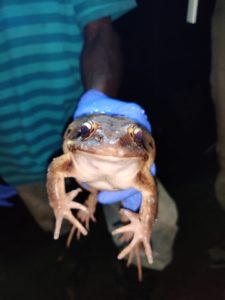 One of the most rewarding parts of the health checks was getting to see the frogs in such close proximity. They seemed so much bigger when they were in my hands, probably partly due to the fact that they had puffed up to look more intimidating. Handling the frogs and seeing them so close up also brought a certain realism to the project- these creatures need our help and their future is quite literally in our hands!
One of the most rewarding parts of the health checks was getting to see the frogs in such close proximity. They seemed so much bigger when they were in my hands, probably partly due to the fact that they had puffed up to look more intimidating. Handling the frogs and seeing them so close up also brought a certain realism to the project- these creatures need our help and their future is quite literally in our hands!
All in all, it was a great experience and we’re very happy to see that the frogs are progressing well and appear to be disease-free so far. Since then, I’ve been practicing my frog-catching skills on the unsuspecting and very abundant cane toads that hop around on nearly every road, so hopefully I will perfect the art in time for the next health check!
Thanks for reading and hopefully see you back here soon!




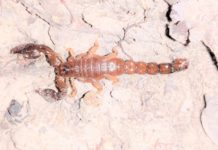


Thanks for the very interesting info on the health checks!